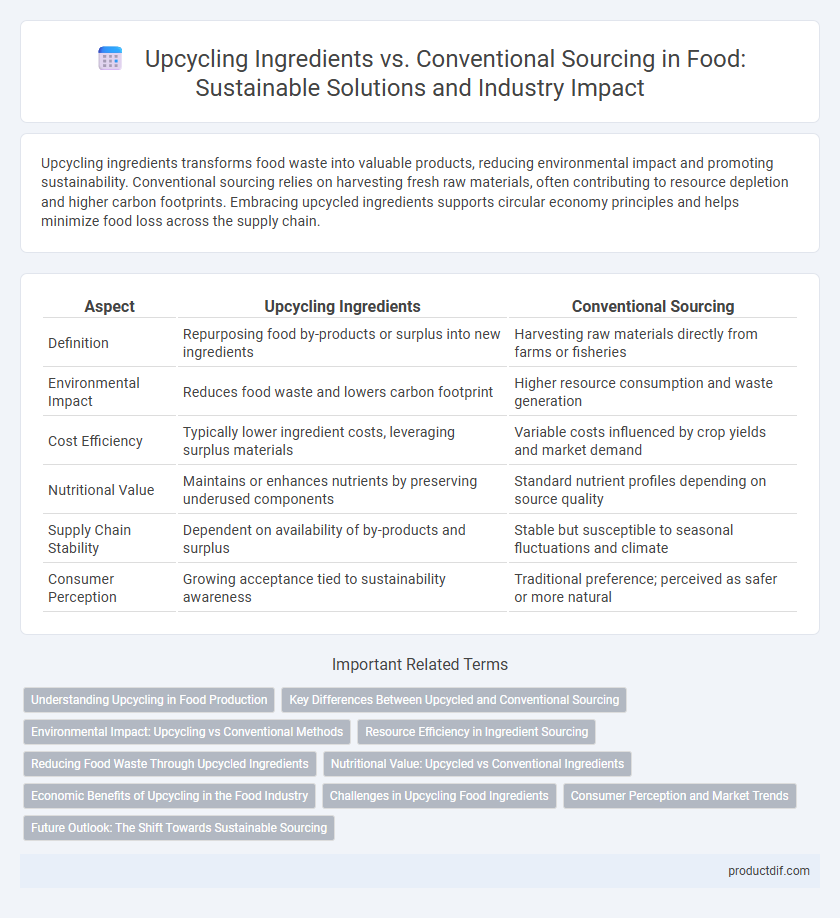Upcycling ingredients transforms food waste into valuable products, reducing environmental impact and promoting sustainability. Conventional sourcing relies on harvesting fresh raw materials, often contributing to resource depletion and higher carbon footprints. Embracing upcycled ingredients supports circular economy principles and helps minimize food loss across the supply chain.
Table of Comparison
| Aspect | Upcycling Ingredients | Conventional Sourcing |
|---|---|---|
| Definition | Repurposing food by-products or surplus into new ingredients | Harvesting raw materials directly from farms or fisheries |
| Environmental Impact | Reduces food waste and lowers carbon footprint | Higher resource consumption and waste generation |
| Cost Efficiency | Typically lower ingredient costs, leveraging surplus materials | Variable costs influenced by crop yields and market demand |
| Nutritional Value | Maintains or enhances nutrients by preserving underused components | Standard nutrient profiles depending on source quality |
| Supply Chain Stability | Dependent on availability of by-products and surplus | Stable but susceptible to seasonal fluctuations and climate |
| Consumer Perception | Growing acceptance tied to sustainability awareness | Traditional preference; perceived as safer or more natural |
Understanding Upcycling in Food Production
Upcycling ingredients in food production transforms surplus or by-products into valuable, nutritious components, reducing food waste and conserving resources compared to conventional sourcing that relies on fresh, primary raw materials. This sustainable approach enhances circular economy practices by diverting edible materials from disposal and lowering environmental impact. By integrating upcycled ingredients, food manufacturers contribute to resource efficiency, cost savings, and improved sustainability credentials.
Key Differences Between Upcycled and Conventional Sourcing
Upcycling ingredients involves repurposing food byproducts or surplus items that would otherwise be discarded, reducing waste and maximizing resource efficiency. Conventional sourcing typically relies on fresh, primary agricultural products harvested specifically for consumption, which can contribute to higher environmental impact and resource depletion. Upcycled sourcing prioritizes sustainability by minimizing food loss and embracing circular economy principles, offering a distinct alternative to traditional supply chains focused on volume and freshness.
Environmental Impact: Upcycling vs Conventional Methods
Upcycling ingredients significantly reduces food waste by repurposing surplus or imperfect food products that would otherwise be discarded, lowering the environmental footprint compared to conventional sourcing. Conventional methods often rely on resource-intensive farming, processing, and transportation, contributing to higher greenhouse gas emissions and increased water usage. By minimizing waste and optimizing resource use, upcycling supports sustainable food systems and promotes circular economy principles in the food industry.
Resource Efficiency in Ingredient Sourcing
Upcycling ingredients significantly enhances resource efficiency by transforming food by-products into valuable inputs, reducing waste and lowering the demand for raw agricultural resources. Conventional sourcing often relies on extensive land, water, and energy consumption, whereas upcycling minimizes environmental impact by maximizing ingredient utilization. Embracing upcycling in ingredient sourcing supports sustainable food production and reduces the carbon footprint associated with conventional supply chains.
Reducing Food Waste Through Upcycled Ingredients
Upcycling ingredients involves repurposing food byproducts and surplus items into nutritious products, significantly reducing food waste compared to conventional sourcing methods that rely on fresh, primary ingredients. This sustainable practice minimizes landfill contributions and lowers greenhouse gas emissions by diverting edible materials otherwise discarded. Incorporating upcycled ingredients supports circular food systems, enhances resource efficiency, and fosters environmental resilience within the food industry.
Nutritional Value: Upcycled vs Conventional Ingredients
Upcycling ingredients often retain more nutrients compared to conventional sourcing because they utilize parts of food typically discarded, such as peels, seeds, and pulp, which are rich in fiber, vitamins, and antioxidants. Conventional ingredients may lose some nutritional value during processing and transportation, leading to lower overall nutrient density. Studies show that upcycled foods can deliver enhanced nutritional benefits while reducing food waste.
Economic Benefits of Upcycling in the Food Industry
Upcycling ingredients in the food industry significantly reduces waste disposal costs and lowers raw material expenses by utilizing by-products and surplus food that would otherwise be discarded. This practice enhances supply chain efficiency and creates new revenue streams through innovative product development, improving overall profitability. Economic benefits also extend to brand differentiation and consumer appeal, attracting eco-conscious customers willing to pay a premium for sustainable foods.
Challenges in Upcycling Food Ingredients
Upcycling food ingredients faces significant challenges including inconsistent supply due to seasonal or variable waste streams, which complicates production planning and scaling. Ensuring food safety and quality standards requires rigorous testing and compliance with regulatory frameworks distinct from conventional sourcing. Limited consumer awareness and acceptance also pose barriers, impacting demand and market growth for upcycled products.
Consumer Perception and Market Trends
Upcycling ingredients appeal to environmentally conscious consumers who prioritize sustainability and reducing food waste, driving a positive market trend towards eco-friendly food products. Conventional sourcing remains dominant but faces increasing scrutiny due to its environmental impact and resource intensity. Consumer demand for transparency and ethical practices accelerates growth in upcycled food markets, creating opportunities for innovation and differentiation.
Future Outlook: The Shift Towards Sustainable Sourcing
Upcycling ingredients reduces food waste by repurposing byproducts and surplus materials, fostering a circular food economy that conserves natural resources. Conventional sourcing often relies on extensive agricultural inputs and transportation, contributing to higher carbon footprints and environmental degradation. Future trends indicate a rising adoption of sustainable sourcing practices, with food manufacturers investing in innovative upcycling technologies to enhance supply chain resilience and meet growing consumer demand for eco-friendly products.
Upcycling Ingredients vs Conventional Sourcing Infographic

 productdif.com
productdif.com